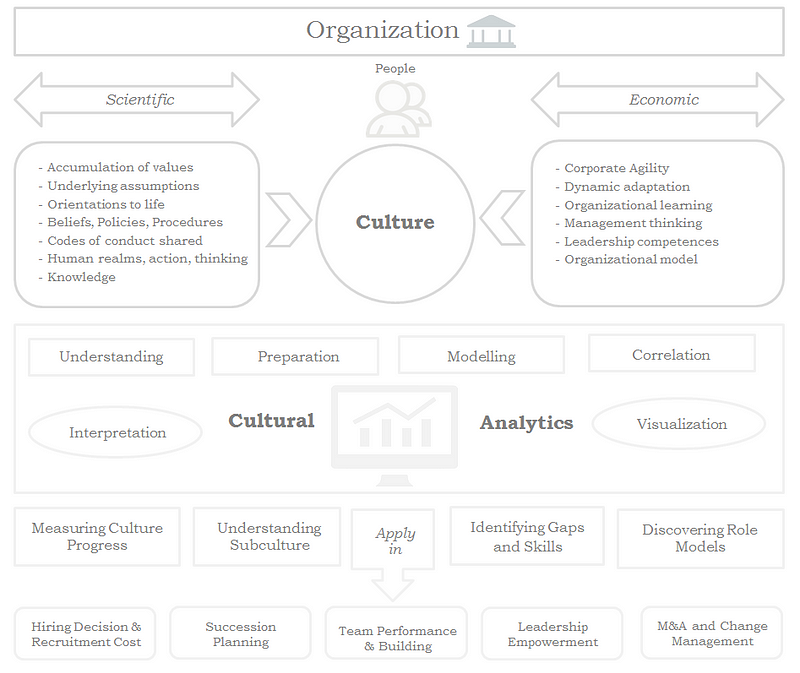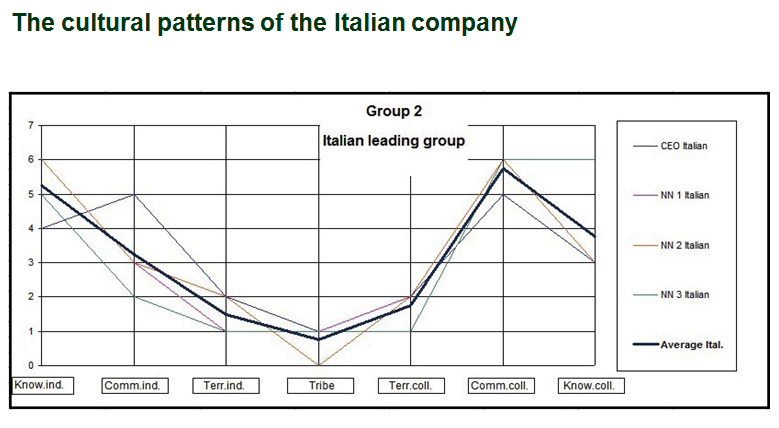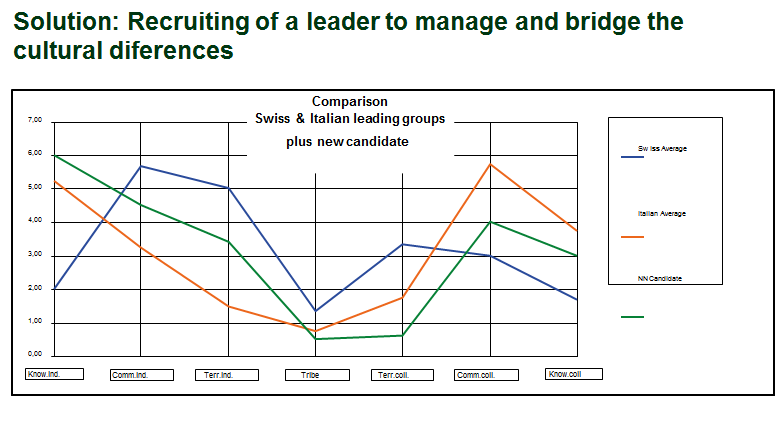Today’s world is more interconnected than ever before, across continents, companies, institutions, generations and cultures. But how do we handle the increased speed and pressure that accompanies this interconnectedness?
In this article I will review the topic of culture and launch the concept of cultural analytics using multiple examples. When leveraged correctly, cultural analytics can create a competitive advantage for your business.

Definition of Culture
Culture is a common term often used to refer to symbolic markers used by ethnic groups to distinguish themselves from each other. But the definition of “Culture” is not simple to understand and indeed a difficult term to define.
In 1952, the American anthropologists, Kroeber and Kluckhohn, critically reviewed concepts and definitions of culture and compiled a list of 164 different definitions. There is a nice compilation of quotations to define “What is Culture” by University of Warwick, UK.
If we had to pick one, we’d best look at the Center for Advanced Research on Language Acquisition.
They defined culture as shared patterns of behaviors and interactions, cognitive constructs and understanding that are learned by socialization. Thus, it can be seen as the growth of a group identity fostered by social patterns unique to the group.
If we look into the scientific background of the culture:
- Culture is the accumulation of values, underlying assumptions and orientations to life, beliefs, policies, procedures, and codes of conduct. These are shared by a group of people that affect the behavior of the members.
- In every human realm, behind an action, knowledge, and thinking, there are components which are cultural values. The simplest and most important value is the assumption of survival and reproduction. The more complex mankind became, the more complex their cultural values grew.
- Behind every bit of knowledge, there is a cultural assumption which is strengthened by knowledge, institutions, and authorities.
Cultural traits
The smallest units of a culture that can be perceived are the Cultural Traits. Examples of these are values, motivations, meaning, preferences, and self-understanding. In order to measure these, we need to explore and define them.
Cultural traits are very important to understand an individual within or outside an organization.
On the other hand, when we start looking into the economic background of culture, we find some different aspects. According to cultural intelligence expert Frode Hvaring, today’s world is more interconnected than ever before.
We connect with ease across continents, across companies, across institutions, across electronic tools for work and life, across generations, and across cultures.
We repeatedly hear — and it’s true — that today’s economies face unprecedented challenges and new opportunities. VUCA (Volatility, Uncertainty, Complexity, and Ambiguity) is impacting your business.
There are many ways to handle the increased speed and pressure in business. But there is no doubt that current and future business leaders at least need to develop a new range of strategic leadership capabilities to remain effective.
Cultural intelligence
One of the most effective response options is to equip leaders with a working understanding of Cultural Intelligence.
This is the capability to adapt and to operate effectively when interacting with other cultures and its successful application. It’s, in fact, providing a huge competitive edge in any multicultural environment.
Corporate agility, dynamic adaptation, organizational learning, leadership competencies, management thought processes and, in fact, the organizational model, determine cultural patterns.
These patterns of shared basic assumptions are learned by a group as it solves its problems of external adaptation and internal integration. If these solutions are considered valid, they are to be taught to new members as the correct way to perceive, think, and feel in relation to those problems.
It defines the corporate culture as well, which is easier to measure. Just setting up values and driving diversity does not provide gain on your corporate culture in terms of company’s vision. Rather, we need to capture its growth and variance over time.
Culture is something which can be derived from the combination of the traits of the individuals from the organizations and corporate behaviors formed from its root and ongoing journey.
Corporate Cultural-Fit
Corporate culture is no longer just a “nice to have”. According to Deloitte, 86% of executives surveyed around the world rate culture as “very important” or “important”. 82% of executives believe that culture is a potential competitive advantage. But only 12% of executives believe they are driving the “right culture”.
According to Multigence, a software company, an organization must focus on fitting individuals into the corporate culture. However, culture isn’t just for your current employees.
It starts the moment a candidate first comes across your brand. And this immediately activates the drivers for your organization’s growth and success, as outlined below.
- Right hiring and promotion
- Proper alignments of skills, including the soft skills
- Taking the right talent decisions
- Fitting to the corporate branding
The culture of the organization is shaped by every single individual. Successful talent decisions will be driven by cultural-fit.
According to Jim Bryson, CEO of 20|20, a qualitative research firm, “Leaders drive culture, culture drives people and the people drive business.”
As a business grows, leaders must be intentional about developing and maintaining a culture. And they are also responsible for changing the culture based on necessity.
Why we need Cultural Analytics
Management guru Peter Drucker once said, “Culture eats strategy for breakfast.” Culture is a key building block. Whether you consider talent acquisition, people engagement, business performance or any transformation, culture is the centerpiece of it all.
Using cultural data to identify the behavioral features of a corporate culture and identifying highly-aligned individuals is essential to the future success of any business.
This data also enables one to hire, develop, and promote using insight about an individual’s degree of alignment with the organization’s current or target culture.
In many cases, we need to re-visit our current culture and drive it in a completely new direction.
As organizations set to transform themselves into technology-enabled, data-driven organizations, they must also shift their culture to a more agile, uncomplicated, collaborative, and customer-focused one that builds on curiosity, open-mindedness, experimentation and learning as core properties of its future.
To achieve these results we need to understand, collect and prepare the different cultural data for further modeling and analysis.
What is Cultural Analytics?
Well, Cultural Analytics is not a new thing to explore. Cultural Analytics is the use of computational and visualization methods to derive and leverage insight about shared values and believes in organizations. The concept of cultural analytics was developed by Lev Manovich in 2005 and the term itself was introduced in 2007.
Cultural Analytics showcase an organization’s shared values and beliefs as reflected in procedures, decisions, competencies and individual behaviors. Using cultural data sets, cultural analytics can help organizations interpret and correlate cultural artifacts. These insights and observations help leaders understand how an organization behaves individually and collectively.
Interpreting the current corporate culture can help an organization with their future success. The existing culture drives the critical decisions and actions that eventually achieve or shape the future goals and objectives.
Therefore, it is not only important to identify the measurable organization’s culture, but to also assess the organization’s ability to achieve its mission and objectives within the chosen strategy. And whenever there are gaps, the culture and/or strategy must be changed in order to achieve success.
Moreover, leaders gain insight into the organization’s strengths and weaknesses. This enables an organization to improve the current performance and to implement change or transformation more smoothly.

We have to consider that there is no one right culture. Different cultures present a specific set of advantages that should be understood and incorporated into the organization’s strategy to ensure an organizational effectiveness.
These values also have a role in the organization’s goals, performance measures, standards and expectations, policies and procedures, rewards & benefits, decisions, organizational learning, and continuous improvement programs.
Today, there are many routes you can take with the data captured from peoples’ skills, their behaviors, beliefs, and other soft aspects. With the addition of statistical data analysis and data visualization techniques, these insights can provide great interpretation of humanities, explanation of anthropology, and correlation of social science.
Benefits
Corporate leaders gained an easy understanding of their culture strengths and weaknesses by grade levels/positions and by functions/units/departments. Thus providing them the insights necessary to better align and optimize overall performance across the organization.
Cultural Analytics can help an organization to reduce costs in recruitment and in reducing turnover. Moreover, it can also help companies improve decision making on hiring and improving team performance.

(Courtesy: Multigence GmbH)
Additionally, it also has implications in:
- Measuring culture progress — to see how the organization is evolving towards its future
- Telling a storyline — the actions, behaviors, and tangibles that make up the employee’s experience in an organization.
- Knowing subcultures and patterns — You can reveal patterns, contradictions, connections, and correlations one may have been missing within unique departments, levels, tenure, gender, race, and generations.
- Identifying skill gaps — You can focus on what’s driving your organization’s success and what might be getting in the way of it. It gives attention to the skills that’s matter the most for your organization and to the things about those skills that actually matter.
- Discover Role Models for Culture — Organizations are increasingly going to the Employee Net Promoter Score as a measure of sentiment, connection, and affiliation.
Case Studies
Case studies for cultural Analytics are in many areas, such as:
- Talent Acquisition
- Merger and Acquisition
- Succession Planning
- Leadership Empowerment
- Organizational Culture Change
- Project Team Creation & Collaboration
- Change Management & Transformation
Below are two examples (more detailed analyses are possible, but not mentioned in this article). These case studies are taken from Multigence GmbH as references and use a wide variety of analysis to reach their conclusions.
Insight 01 (Leadership Empowerment & Transformation)
Background
A Swiss company is known as one of the leaders in their respective industry. Many newcomers and other organizations look to this company as their role model.
Challenge
A large number of leaders in this Swiss company have been around for a long time. They are individual thought leaders in their respective areas, but most of them are not collaborative enough and lack engagement on the organization level.
The company needs to find the right team and key leaders at different levels of engagement for their future transformation and organization modeling projects. If they fail to do so, it can lead to low productivity & performance and high turnover rate.
Solution
By comparing the culture profiles between leaders at different levels of the company’s structure using cultural analytics, one can easily distinguish the leadership skills needed for the future transformation and modeling.
Companies can easily set a role model for each trait of culture or skills for future transformation and changes. This gives an insightful picture of the company’s current culture on leadership and details where it is lacking.


Insight 02 (Merger & Acquisition)
Background
An old, traditional and successful Swiss company in the field of wood-making machines, which was very successful in the world market, decided to innovate by acquiring a young and dynamic Italian software development company from Italy.
Challenge
The merger succeeded, but the transfer of knowledge was, for a long time, only minor. The analysis showed: The cultures did not fit together. There was a culture of “Success and Tradition” against a culture of “Knowledge and Cooperation“.
Reason: The different management ideals of both companies clashed
Solution
The solution was made by recruiting a new leading employee, who was able to bridge the two cultural differences with his/her personal leadership skills (because he/she would be able to communicate with the strongly divergent cultural aspects of both companies).
The recruiting was carried out with Cultural Analytics, in order to make the bridging function of the new employee visible.
Below you see three images that visualize the culture scores for the Swiss and the Italian company, and for the new candidate. As you can see, the candidate’s profile fits right in the middle of the cultures of both companies.



Further Interesting Terminologies
Culturomics is a form of computational lexicology that studies human behavior and cultural trends through the quantitative analysis of digitalized texts. Researchers data mine large digital archives to investigate cultural phenomena reflected in language and word usage.
Cultural intelligence is a term used in business, education, government and academic research. Cultural intelligence can be understood as the capability to relate and work effectively across cultures.
In business, Cultural intelligence, also known within business as “cultural quotient” or “CQ”, is a theory within management and organizational psychology. It claims that understanding the impact of an individual’s cultural background on their behavior is essential for effective business. Measuring an individual’s ability to engage successfully in any environment or social setting is also essential for effective business.
The future
Cultural awareness alone isn’t enough. Organizations need leaders, teams, and staff who can simultaneously advance the values and needs of an organization, while adapting to the cultures touched by the organization.
Today, Cultural Analytics can play a pivotal role for the organizations as mentioned in various areas and cases. If you are interested to discuss more, please feel free to contact me.
Originally published at www.analyticsinhr.com on January 29, 2018.


